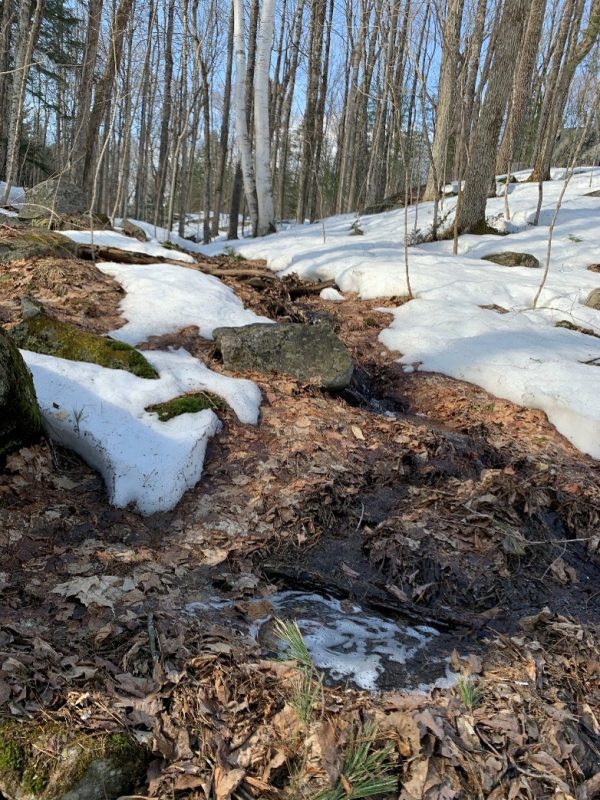How much stress is too much? When does a system suffer change?
By Neil Hutchinson | Published August 14, 2025

High on a ridge, many years ago, retreating glaciers revealed a small depression in the bedrock of the Precambrian Shield. Over centuries, sparse sands and gravels were enriched with decaying vegetation from the developing forests and the depression filled with rich waterlogged loam. When it rained, the wetland absorbed the water until it was saturated and then a small spring discharged the overflow of subsurface water from the wetland forming a small stream.
In March, the winter snowpack melted slowly as the sun warmed the surrounding air. Some of the melt water percolated into the wetland and, on very warm spring days, the melt ran over the surface as well, causing the small stream to grow to a freshet. The freshet fed other similar streams which joined together as they flowed downstream.
Some melt water, however, did not join the downstream flow. The surrounding forest woke from winter as the days warmed, and thirsty roots pulled water from the soil, moving it into the tissues of the maple trees as sweet sap and then into the air as transpiration. The days grew warmer and gentle rains fell, adding to the reservoir of groundwater in the soils above the hard bedrock. The stream hit its late spring peak of runoff and dropped to a steady flow, sustained mainly by the groundwater, that lasted into the summer. The stream flowed cold, kept that way by the shelter of the forest and the wetland, even throughout the hot days of July. Brook trout thrived in the cool shaded water and sought the upwellings of cold groundwater for spawning in the fall.
This pattern repeated itself for centuries. Plant, animal and Indigenous communities thrived in the system in which they had evolved. The health of the trees was sustained by minerals such as calcium, which leached out of the rock and soils and was taken up by their roots. There was a balance, however, as much of the calcium that was taken up when the trees were growing was returned to the soil when the leaves fell in the autumn or when the trees died, fell and rotted.
Things started changing with the arrival of Europeans. Clearcutting of the forest for harvest resulted in removal of calcium with the timber. As well, the diminished forest transpired less water and summer storms led to faster runoff into the stream, warming the water. Massive industrialization in North America in the 20th century turned the rain acidic, and this acid quickly leached remaining calcium from the soils and bedrock, moving it out of the reach of the forest and into waterways downstream. The health of the forest suffered so that even less water was transpired; more rainfall ran off into the stream in the spring. Summer storms uprooted the weakened trees, exposing more of the forest floor to the sun and speeding the runoff of warmer water into the stream.
Continued global industrialization and associated greenhouse gases caused the atmosphere to warm, such that the wetland dried out and stored less cool water to sustain the stream in the now hotter summers. Rainstorms were more violent, unleashing torrents of runoff to the stream in the summer, changing the stream bed itself as the energy in the flow eroded the banks. The original pattern of gradual spring melt and slow sustained runoff was lost because winter snow increasingly fell as rain and ran off in more frequent mid-winter thaws, leaving less meltwater to feed the wetland and the stream later in the year. The stream was changed profoundly. Brook trout disappeared.
Forest harvest, acid rain, and a warming climate each produced small effects on the stream and wetland, but when combined, their cumulative actions resulted in far more profound changes and the loss of the coldwater stream. Detecting and understanding such small changes is a challenge to both scientists and the public. We need to appreciate the significance of small changes and mitigate them in order to avoid facing the question of “How warm does it have to get before we act?”
This is Article No. 7 from Muskoka Watershed Council’s current series, Living Smarter in Muskoka, edited by Peter Sale. The author is Dr. Neil Hutchinson, a retired environmental scientist, resident of the North Muskoka River Watershed, member of the Muskoka Watershed Council and Georgian Bay Forever and Director of The Friends of the Muskoka Watershed.

This is Article No. 7 from Muskoka Watershed Council’s current series, Living Smarter in Muskoka, edited by Peter Sale. The author is Dr. Neil Hutchinson, a retired environmental scientist, resident of the North Muskoka River Watershed, member of the Muskoka Watershed Council and Georgian Bay Forever and Director of The Friends of the Muskoka Watershed.
First published on muskokaregion.com
